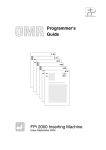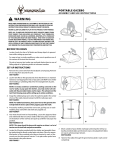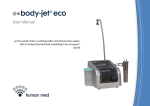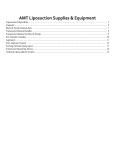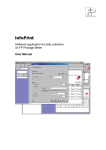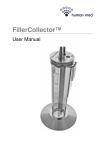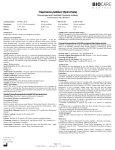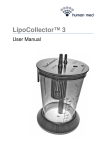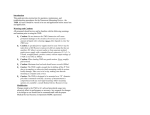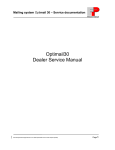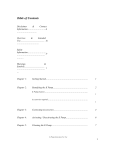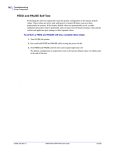Download 1. Frequently asked questions on clinical use
Transcript
1.5. As the device manufacturer we cannot give any recommendation which fluid is to be used for liposuction. Please refer to the publications issued by Jayashree Venkataram. Tumescent Liposuction: A Review. J Cutan Aesthet Surg. 2008 Jul-Dec; 1(2): 49–57. 1. Frequently asked questions on clinical use 1.1. How much fluid should be used per body area? § § § § § Abdomen: 200 to 800 ml Hips: 100 to 200 ml each Buttocks: 300 ml each Inner thighs: 100 ml each Outer thighs: 150 to 200 ml each 1.6. 1.7. How long shall I wait after infiltration of the fluid until I can start the liposuction? Why does the OP take such a long time when performing WAL for the first times? If you have just started to work with the WAL method (Water-jet Assisted Liposuction), you may need more time for the OP. Don’t be discouraged! After some practice, that means, from experience, after 7 to 10 interventions, you will reach OP times which are hardly possible with any other liposuction procedure. 1.4. 1.8. All cannulas are available in various lengths, diameters and suction opening designs (see our current Product List). There is relatively much blood in the aspirate. Why? Our user have determinded the following possible reasons: § Too little fluid has been infiltrated. Please ensure that a suitable volume of tumescent fluid is infiltrated. § You may have applied too much pressure on the tissue with the cannula during liposuction. Please pay heed to always work with smooth cannula movements in a large body area. § The adrenaline in the tumescent fluid is not effective enough. Make sure that the tumescent fluid is not exposed to bright light and the adrenaline is not too old, has been stored and dispensed properly for the operation. Which cannulas are used for which applications? Human med provides a wide range of WAL cannulas. The surgeon individually decides for each patient which cannula is used. § Infiltration cannula This cannula is exclusively used for infiltration of the tumescent fluid. The infiltration cannula with the smallest diameter of 2.5 mm is particularly suitable for the infiltration into fibrotic tissue. § Standard W AL cannulas Irrigation and aspiration cannulas for the standard WAL, recognizable by the gold-colored handle § Stainless steel cannulas of the STS series Irrigation and aspiration cannulas made of stainless steel, required for liposuction with subsequent autologous fat transfer, recognizable by the stainless steel handle § W AL cannulas of the SC series Subcutaneous irrigation and aspiration cannulas for a particularly precise contouring in superficial body areas and near the fascia; recognizable by the green handle § W AL cannulas of the RAPID series Irrigation and aspiration cannulas for a rapid and large-volume liposuction; particularly suitable for the treatment of scarred and fibrotic tissue due to the special edge grinding of the suction openings; recognizable by the silver-colored handle or the lettering “RAPID” on the cannula tube § Aspiration cannula w ith spoon-shaped tip Irrigation and aspiration cannulas with a specially shaped cannula tip for the effective and gentle removal of the perspiratory glands The volume of the fat I have aspirated is very small. Why? This can have various reasons: § The vacuum may be too weak. You find an exact fault description and appropriate solutions in Chapter VIII of the user manual for the body-jet®. § You work optimally when you smoothly move the cannula back and forth in a large body area. This ensures that enough fat is aspirated through the cannula openings. § The WAL cannula may be blocked. Remove the cannula from the hand-piece of the WAL applicator and wipe the nozzle capillary with a sterile cloth. Then attach the WAL cannula to the hand-piece again. You can start the liposuction immediately after infiltration of the fluid, since you don’t have to wait until the reaction time is over. Tip: Start with the body area you have infiltrated first. 1.3. How can I work efficiently with the irrigation/ aspiration cannula? You work efficiently when you slowly and smoothly move the cannula back and forth over a large body area. This ensures that enough fat is aspirated through the cannula openings. You can substantially increase the efficiency of the liposuction by working in the following manner: Whilst slowly moving the cannula forward in the tissue, activate the water-jet at the same time by pressing the foot-bellows. When pulling the cannula back, you do not need the water-jet (do not actuate the foot-bellows). This way of working requires some practice. However, not more than 1000 ml should be used before starting the liposuction. The decision how much fluid will be infiltrated, is made by the surgeon! 1.2. Which fluid may I use for liposuction? 1.9. The aspirate contains too much liquid and too little fat. Why? A reason may be that too much fluid has been infiltrated. Please ensure that a suitable volume of fluid is infiltrated. You may need to reduce the RANGE to 1 or 2. The functionality of the LipoCollector® 3 / FillerCollector® is based on the principle of floating filtration. As soon as the liquid has reached the height of the suction pipe within the separation pipe of the LipoCollector® 3, the aqueous part is automatically sucked off whereas the collected fat remains in the container. 1.10. How can I reduce the aqueous part of the fat aspirate before re-injection? Prior to fat extraction and transfer into the syringes, the excessive liquid should be removed from the LipoCollector® 3/ FillerCollector® using the water straw. This procedure is described in detail in the user manuals for the LipoCollector® 3 and the FillerCollector®. Allow the syringes filled with the fat to stand for a couple of minutes with the tip pointing downwards. The excess liquid then runs to the syringe tip and can be expelled before fat reinjection. 1.11. Can I aspirate more fat using other methods? According to our users experience no. However, this impression could arise because the cell clusters harvested with the body-jet® are smaller, finer and more evenly spread in the solution than fat cells harvested with other methods. These small cell clusters (approx. 0.9 mm) are more suited for re-injection and better adhere to the host tissue. During a WAL, at least the same volume of fat is aspirated per time unit as in all other liposuction procedures. Tips & Tricks around the body-jet® 2. Technical questions 2.1. How do I introduce the suction bag correctly into the suction container? Please remember to unfold the suction bag completely before use. Do not apply pressure when introducing it into the suction container. Under vacuum, the suction bag nestles to the container wall and takes up in the right position. You will find a detailed description of the procedure including photos in section VI.2.2 of the User Manual for the body-jet®. 2.2. Which device settings shall I make for liposuction with subsequent fat transfer? For a liposuction with subsequent fat transfer we recommend adjusting the vacuum to a maximum level of -500 mbar and selecting RANGE 2 in order not to destroy the fat cells. When setting the required vacuum, switch the vacuum change-over switch to the vertical position. Watch the vacuum gauge and turn the adjusting knob of the vacuum regulator until the required vacuum is indicated on the vacuum gauge. Before starting the liposuction turn the vacuum change-over switch towards the suction container to be used. 2.3. I have actuated the foot-bellows, but no fluid comes out of the cannula. Why? This may be for various reasons. Possible reasons and solutions are described in detail in chapter VIII of the user manual for the body-jet®. 2.4. I cannot remove the infiltration pump from the device. Why? Please refer to the user manual if this problem occurs. You will find a detailed description of the removal procedure in section VI.7 and clear instructions on how to solve possible problems in chapter VIII. 2.5. Is the WAL applicator suitable for reprocessing? No! The WAL applicator is not suitable for reprocessing because remaining bacteria could lead to infection. Also reprocessing may have an adverse effect on its material: it may wear out, deform or swell. This may considerably affect the applicator’s functionality or make the applicator unusable. The WAL applicator is intended for single use only; it must not be reprocessed and reused! Each medically indicated information given in this brochure is based on the experience of our users. In particular Dr. med Klaus Ueberreiter made a substantial contribution with his analyses; he also was significantly involved in issuing this brochure. We thank Dr. Ueberreiter for his support and analyses. Should you have further questions, you may contact him directly: Park Klinik Birkenwerder, Phone.: 03303-5134000-0; [email protected] Before using the body-jet® please read the user manual carefully. These “Tips & Tricks“ do not replace the user manual. They are based on the application experience gained in the last few years. The handling and parameter setting for the body-jet® are the user’s responsibility. 1. Frequently asked questions on clinical use 1.1. How much tumescent fluid should be infiltrated per body area? 1.2. How long shall I wait after infiltration until I can start the liposuction? 1.3. Why does the OP take such a long time when performing WAL for the first times? 1.4. Which cannulas are used for which applications? 1.5. Which tumescent fluid may I use for liposuction? 1.6. How can I work efficiently with the irrigation/ aspiration cannula? 1.7. The volume of the fat I have aspirated is very small. Why? 1.8. There is relatively much blood in the aspirate. Why? 1.9. The aspirate contains too much liquid and too little fat. Why? 1.10. How can I reduce the aqueous part of the fat aspirate before re-injection? 1.11. Can I aspirate more fat using other methods? 2. Technical questions 2.1. How do I introduce the suction bag correctly into the suction container? 2.2. Which device settings shall I make for liposuction with subsequent fat transfer? 2.3. I have actuated the foot-bellows, but no fluid comes out of the cannula. Why? 2.4. I cannot remove the infiltration pump from the device. Why? 2.5. Is the WAL applicator suitable for reprocessing? © hu ma n med AG 2 01 3– rev0


